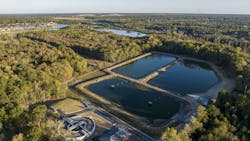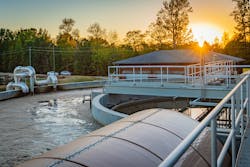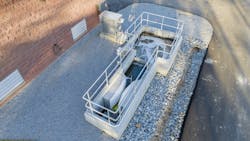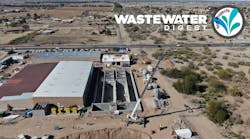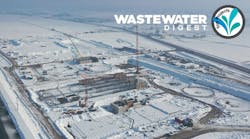Located in Pulaski County northeast of Little Rock, Arkansas, Gravel Ridge SID 213 serves 1,500 customers, including residents of Sherwood and Jacksonville. Facultative lagoons were a primary feature of the treatment process at this plant, and like many facilities with lagoons and of a similar age, the process is no longer sufficient to meet the new effluent water quality standards imposed by the state, particularly with nutrient limits.
Wastewater entered the former treatment plant from two separate pump stations, which handled the flows from two drainage basins. That liquid was then fed into those lagoons, which would occasionally find the facility exceeding its permitted flow limits. After treatment at the plant, the wastewater is discharged into the receiving stream with an effluent submersible pump station.
Marlar said a primary challenge was using the existing lagoons with the new construction. By repurposing the lagoons as equalization basins, Marlar said Gravel Ridge SID 213 saved more than $2.5 million on project costs.
“We achieved this by modifying the piping so that the existing lagoons could be used for an equalization basin to hold wet weather flows during rain events,” Marlar said. “In addition to the lagoons being used as equalization basins, they held sludge waste for storage.”
By repurposing the lagoons, Gravel Ridge SID 213 was able to overcome both of the primary concerns it was facing with its permitted flow and the new effluent regulations. To do so, however, Gravel Ridge and Halff were concerned with the flow and the potential impacts on the food to microorganism ratio. As such, the team needed accurate flow records to ensure the treatment process was not negatively impacted.
In fact, the maximum influent flow was greater than both the permit and the peak design rating of the new plant to be constructed. Marlar said this led to diverting the excess flow to equalization ponds and designing the pumps to handle the flow variations.
“Halff engineers designed a new influent pump station to receive flow from both force mains and discharge to the new treatment plant headworks and a secondary discharge header to the lagoons for wet weather flow storage,” he said.
The new construction was intentionally built away from the existing site and operations to reduce service disruption during the project.
“We built the new treatment plant away from the current existing operations even though they were on the same site,” Marlar said. “There was no interruption in the treatment process while the new one was being built. Once the new treatment plant was completed, the existing facility was deactivated and decommissioned.”
Watch the Gravel Ridge Top Projects video:
